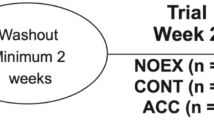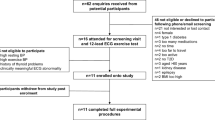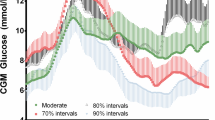Abstract
Purpose
It is reported that a single bout of exercise can lower insulin responses 12–24 h post-exercise; however, the insulin responses to alternate or consecutive bouts of exercise is unknown. Thus, the purpose of this study was to examine the effect of exercise pattern on post-exercise insulin and glucose responses following a glucose challenge.
Methods
Ten male participants (n = 10, mean ± SD, Age 29.5 ± 7.7 years; BMI 25.7 ± 3.0 kg/m2) completed three exercise trials of walking for 60 min at ~ 70% of VO2max. The trials consisted of: three consecutive exercise days (3CON), three alternate exercise days (3ALT), a single bout of exercise (SB), and a no exercise control (R). Twelve to fourteen hours after the last bout of exercise or R, participants completed a 75 g oral glucose tolerance test (OGTT) and blood was collected at 30 min intervals for the measurement of glucose, insulin, and C-peptide.
Result
Calculated incremental area under the curve (iAUC) for glucose and C-peptide was not different between the four trials. Insulin iAUC decreased 34.9% for 3CON compared to R (p < 0.01).
Conclusion
Three consecutive days of walking at ~ 70% VO2max improved insulin response following an OGTT compared to no exercise. It is possible, that for healthy males, the effect of a single bout of exercise or exercise bouts separated by more than 24 h may not be enough stimulus to lower insulin responses to a glucose challenge.



Similar content being viewed by others
Abbreviations
- AUC:
-
Area under the curve
- iAUC:
-
Incremental area under the curve
- OGTT:
-
Oral glucose tolerance test
- 3ALT:
-
Three alternate days
- 3CON:
-
Three consecutive days
References
Ben-Ezra V, Jankowski C, Kendrick K, Nichols D (1995) Effect of intensity and energy expenditure on postexercise insulin responses in women. J Appl Physiol 79(6):2029–2034
Bird SR, Hawley JA (2016) Update on the effects of physical activity on insulin sensitivity in humans. BMJ Open Sport Exerc Med 2(1):e000143
Borst SE (2004) The role of TNF-alpha in insulin resistance. Endocrine 23(2–3):177–182
Brestoff JR, Clippinger B, Spinella T, Duvillard SPV, Nindl B, Arciero PJ (2009) An acute bout of endurance exercise but not sprint interval exercise enhances insulin sensitivity. Appl Physiol Nutr Metab 34(1):25–32
Burstein RY, Epstein Y, Shapiro Y, Charuzi I, Karunieli E (1990) Effect of an acute bout of exercise on glucose disposal in human obesity. J Appl Physiol (1985) 69(1):299–304
Cartee GD, Young DA, Sleeper MD, Zierath J, Wallberg-Henriksson H, Holloszy JO (1989) Prolonged increase in insulin-stimulated glucose transport in muscle after exercise. Am J Physiol 256:E494–E499
Coderre L (1992) Alteration in the expression of GLUT-1 and GLUT-4 protein and messenger RNA levels in denervated rat muscles. Endocrinology 131(4):1821–1825
Cohen J, Cohen P, West SG, Aiken LS (2015) Applied multiple regression/correlation analysis for the behavioral sciences. Routledge, New York
Colberg SR, Sigal RJ, Fernhall B, Regensteiner JG, Blissmer BJ, Rubin RR, Chasan-Taber L, Albright AL, Braun B, American College of Sports Medicine, American Diabetes Association (2010) Exercise and type 2 diabetes: the American College of Sports Medicine and the American Diabetes Association: joint position statement executive summary. Diabetes Care 33(12):2692–2696. https://doi.org/10.2337/dc10-1548
Cononie CC, Goldberg AP, Rogus E, Hagberg JM (1994) Seven consecutive days of exercise lowers plasma insulin responses to an oral glucose challenge in sedentary elderly. J Am Geriatr Soc 42(4):394–398
Devlin JT, Hirshman M, Horton ED, Horton ES (1987) Enhanced peripheral and splanchnic insulin sensitivity in NIDDM men after single bout of exercise. Diabetes 36(4):434–439. https://doi.org/10.2337/diab.36.4.434
Garcia-Roves PM, Han DH, Song Z, Jones TE, Hucker KA, Holloszy JO (2003) Prevention of glycogen supercompensation prolongs the increase in muscle GLUT4 after exercise. Am J Physiol Endocrinol Metab 285(4):E729–E736
Green HJ, Bombardier E, Duhamel TA, Stewart RD, Tupling AR, Ouyang J (2008) Metabolic, enzymatic, and transporter responses in human muscle during three consecutive days of exercise and recovery. Am J Physiol Regul Integr Comp Physiol 295(4):R1238–R1250
Hasson RE, Granados K, Chipkin S, Freedson PS, Braun B (2010) Effects of a single exercise bout on insulin sensitivity in black and white individuals. J Clin Endocrinol Metab 95(10):E219–223
Hayashi T, Boyko EJ, Sato KK, McNeely MJ, Leonetti DL, Kahn SE, Fujimoto WY (2013) Patterns of insulin concentration during the OGTT predict the risk of type 2 diabetes in Japanese Americans. Diabetes Care 36(5):1229–1235
Helmrich SP, Ragland DR, Leung RW, Paffenbarger RS Jr (1991) Physical activity and reduced occurrence of non-insulin-dependent diabetes mellitus. N Engl J Med 325(3):147–152
Houmard JA, Tanner CJ, Slentz CA, Duscha BD, McCartney JS, Kraus WE (2004) Effect of the volume and intensity of exercise training on insulin sensitivity. J Appl Physiol 96:101–106
Jankowski C, Ben-Ezra V, Kendrick K, Morriss R, Nichols D (1999) Effect of exercise on postprandial insulin responses in Mexican American and non-Hispanic women. Metabolism 48(8):971–977
Jankowski CM, Ben-Ezra V, Gozansky WS, Scheaffer SE (2004) Effects of oral contraceptives on glucoregulatory responses to exercise. Metabolism 3(53):348–352
Jensen J, Aslesen R, Ivy JL, Brors O (1997) Role of glycogen concentration and epinephrine on glucose uptake in rat epitrochlearis muscle. Am J Physiol 272(4 Pt 1):E649–E655
Knudsen SH, Karstoft K, Pedersen BK, van Hall G, Solomon TP (2014) The immediate effects of a single bout of aerobic exercise on oral glucose tolerance across the glucose tolerance continuum. Physiol Rep 2(8):1–13
Mikus CR, Oberlin DJ, Libla JL, Taylor AM, Booth FW, Thyfault JP (2012) Lowering physical activity impairs glycemic control in healthy volunteers. Med Sci Sports Exerc 44(2):225–231
Miller WG, Thienpont LM, Van Uytfanghe K et al (2009) Toward standardization of insulin immunoassays. Clin Chem 55(5):1011–1018
Newsom SA, Schenk S, Thomas KM, Harber MP, Knuth ND, Goldenberg N, Horowitz JF (2010) Energy deficit after exercise augments lipid mobilization but does not contribute to the exercise-induced increase in insulin sensitivity. J Appl Physiol (1985) 108(3):554–560. https://doi.org/10.1152/japplphysiol.01106.2009
Newsom SA, Everett AC, Hinko A, Horowitz JF (2013) A single session of low-intensity exercise is sufficient to enhance insulin sensitivity into the next day in obese adults. Diabetes Care 36(9):2516–2522. https://doi.org/10.2337/dc12-2606
Ormazabal V, Nair S, Elfeky O, Aguayo C, Salomon C, Zuniga F (2018) Association between insulin resistance and the development of cardiovascular disease. Cardiovasc Diabetol 17(1):122
Richter EA, Hargreaves M (2013) Exercise, GLUT4, and skeletal muscle glucose uptake. Physiol Rev 93(3):993–1017
Riebe D, Ehrman JK, Liguori G, Magal M (2018) ACSM’s guidelines for exercise testing and prescription. Wolters Kluwer, Philadelphia, p 151
Rivas E, Wooten JS, Newmire DE, Ben-Ezra V (2016) Omega-3 fatty acid supplementation combined with acute aerobic exercise does not alter the improved post-exercise insulin response in normoglycemic, inactive and overweight men. Eur J Appl Physiol 116(6):1255–1265
Rogers MA, Yamamoto C, King DS, Hagberg JM, Ehsani AA, Holloszy JO (1998) Improvement in glucose tolerance after 1 wk of exercise in patients with mild NIDDM. Diabetes Care 11(8):613–618
Schell TC, Wright G, Martino P, Ryder J, Craig BW (1999) Postexercise glucose, insulin, and c-peptide responses to carbohydrate supplementation: running vs. resistance exercise. J Strength Cond Res 13(4):372–380
Short KR, Pratt LV, Teague AM (2012) The acute residual effect of a single exercise session on meal glucose tolerance in sedentary young adults. J Nutr Metab 2012:1–9. https://doi.org/10.1155/2012/278678
Taylor HL, Wu CL, Chen YC, Wang PG, Gonzalez JT, Betts JA (2018) Post-exercise carbohydrate-energy replacement attenuates insulin sensitivity and glucose tolerance the following morning in healthy adults. Nutrients. https://doi.org/10.3390/nu10020123
Umpierre D (2011) Physical activity advice only or structured exercise training and association with HbA1cLevels in type 2 diabetes. JAMA 305(17):1790
Van Dijk JW, Tummers K, Stehouwer C, Hartgens F, van Loon LJ (2012) Exercise therapy in type 2 diabetes. Diabetes Care 35:948–954
Weiss EP, Arif H, Villareal DT, Marzetti E, Holloszy JO (2008) Endothelial function after high-sugar-food ingestion improves with endurance exercise performed on the previous day. Am J Clin Nutr 88(1):51–57
Young JC, Enslin J, Kuca B (1989) Exercise intensity and glucose tolerance in trained and nontrained subjects. J Appl Physiol 67(1):39–43
Zorzano A, Balon TW, Goodman MN, Ruderman NB (1986) Additive effects of prior exercise and insulin on glucose and AIB uptake by rat muscle. Am J Physiol 251(1 Pt 1):E21–E26
Acknowledgment
This study was supported in part by the Texas Woman's University Office of Research and Sponsored Programs, as well as the Department of Kinesiology. SED is currently supported by a T32 Postdoctoral Award from the National Institute of Diabetes and Digestive and Kidney Diseases (T32DK062710). The content is solely the responsibility of the authors and does not necessarily represent the official views of the NIDDK or the NIH.
Author information
Authors and Affiliations
Contributions
TC was responsible for collecting and analyzing data, and writing the manuscript. CI and RG were responsible for collecting data, analyzing data, and manuscript revisions. SD collected data and reviewed and edited the manuscript. MB, MO, and JR collected and analyzed data. AD reviewed data and edited manuscript. VB designed the research study, collected the data, and edited the manuscript.
Corresponding author
Ethics declarations
Conflict of interest
The authors have no conflicts of interest to declare.
Additional information
Communicated by Philip D Chilibeck.
Rights and permissions
About this article
Cite this article
Castleberry, T., Irvine, C., Deemer, S.E. et al. Consecutive days of exercise decrease insulin response more than a single exercise session in healthy, inactive men. Eur J Appl Physiol 119, 1591–1598 (2019). https://doi.org/10.1007/s00421-019-04148-z
Received:
Accepted:
Published:
Issue Date:
DOI: https://doi.org/10.1007/s00421-019-04148-z




